地震地质 ›› 2025, Vol. 47 ›› Issue (1): 131-149.DOI: 10.3969/j.issn.0253-4967.2025.01.009
收稿日期:2024-08-13
修回日期:2025-01-16
出版日期:2025-02-20
发布日期:2025-04-09
作者简介:余博文, 男, 1995年生, 现为中国地震局地质研究所固体地球物理学专业在读博士研究生, 从事构造物理学以及诱发地震机理研究, E-mail: ybw_nepu@163.com。
基金资助:
YU Bo-wen( ), MA Sheng-li, ZHANG Lin
), MA Sheng-li, ZHANG Lin
Received:2024-08-13
Revised:2025-01-16
Online:2025-02-20
Published:2025-04-09
摘要:
工业注水可引起断层所受应力的扰动, 进而对区域内的地震活动性造成影响。通过实验研究正应力扰动对断层滑动行为的影响有助于理解诱发、触发地震活动机制。文中使用双剪样品结构开展了不同正应力扰动振幅条件下天然断层泥和盐岩断层泥的摩擦实验, 并对断层附近应变场和声发射进行观测。随着正应力扰动振幅增加, 2种断层泥的黏滑应力降增大, 天然断层泥的黏滑时间间隔逐渐增大并趋于离散, 成核位置增多且该阶段无声发射事件。然而盐岩断层泥的黏滑时间间隔几乎不变且始终保持同一位置成核, 其成核时间和和范围随扰动振幅的增加而增大, 声发射事件位置与成核区基本吻合。断面非均匀性和断层泥模量的差异可解释2种断层泥带附近应变场演化的差异。文中研究可为构建考虑应变非均质性和不同断层泥成分的地震成核模型提供实验观测依据。
余博文, 马胜利, 张林. 正应力扰动条件下断层泥带黏滑行为、应变场和声发射时空演化特征[J]. 地震地质, 2025, 47(1): 131-149.
YU Bo-wen, MA Sheng-li, ZHANG Lin. EFFECTS OF NORMAL STRESS OSCILLATION ON THE STICK-SLIP BEHAVIOR, NEAR-FAULT STRAIN FIELD AND ACOUSTIC EVENTS FOR FAULT GOUGE LAYERS[J]. SEISMOLOGY AND GEOLOGY, 2025, 47(1): 131-149.
| 实验编号 | 断层泥 | 加载速度 /μm·s-1 | 背景有效正应力 /MPa | 正应力扰动频率 /Hz | 正应力扰动振幅 /% |
|---|---|---|---|---|---|
| HBR-21-89 | 天然断层泥 | 0.05 | 10 | 0.1 | 0.2—0.7—1.2—2.4 |
| HBR-22-36 | 盐岩断层泥 | 0.5 | 5 | 0.1 | 0.2—0.6—1—2 |
表1 实验条件汇总
Table1 Summary of experimental set-up
| 实验编号 | 断层泥 | 加载速度 /μm·s-1 | 背景有效正应力 /MPa | 正应力扰动频率 /Hz | 正应力扰动振幅 /% |
|---|---|---|---|---|---|
| HBR-21-89 | 天然断层泥 | 0.05 | 10 | 0.1 | 0.2—0.7—1.2—2.4 |
| HBR-22-36 | 盐岩断层泥 | 0.5 | 5 | 0.1 | 0.2—0.6—1—2 |

图2 剪应力定量描述参数, 包括断层弱化程度Δτw、黏滑应力降Δτ及黏滑时间间隔ΔT
Fig. 2 Parameters used to analyze the fault shear stress, including fault weakening Δτw, shear stress drop Δτ, time interval of stick-slip event ΔT.
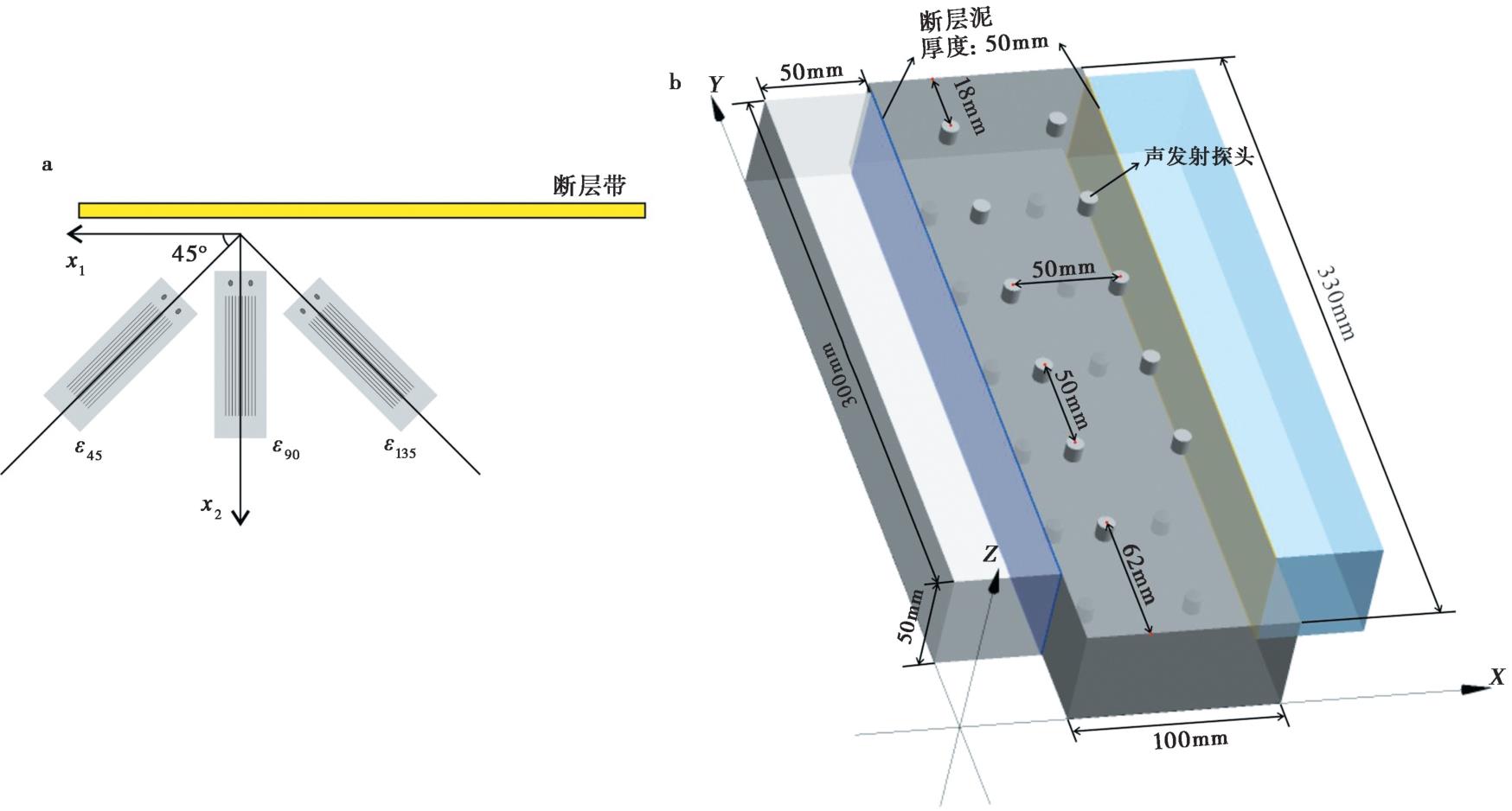
图3 应变花和声发射传感器空间位置示意图 a 单一应变花内3个应变片与实验断层带的位置关系示意图; b 声发射传感器位置分布三维图解。应变和声发射数据处理均遵循图b所示坐标系
Fig. 3 Schematic diagram showing the location of the strain rosettes and the acoustic sensors.
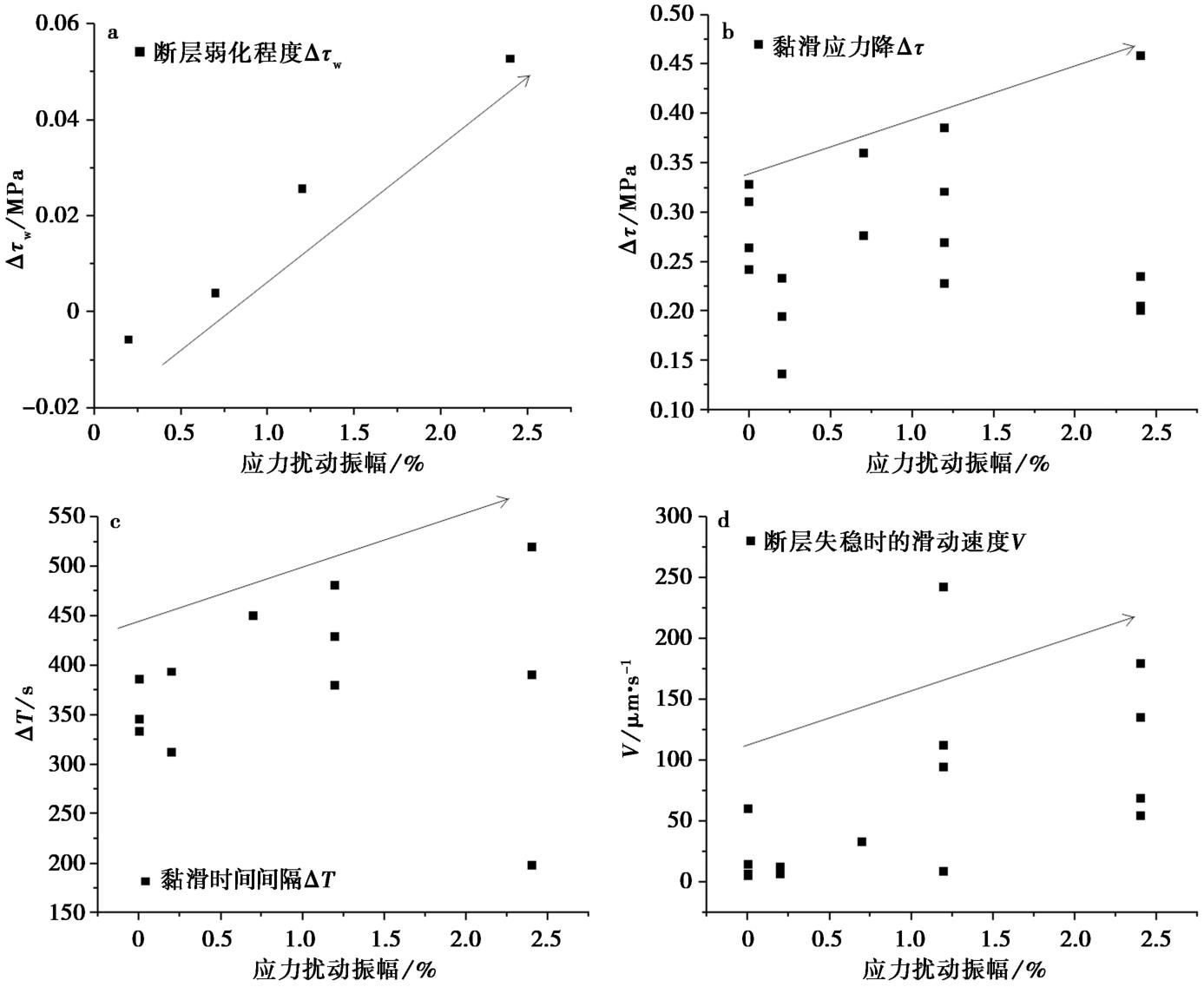
图4 正应力扰动振幅对天然断层泥黏滑行为的影响 a 断层弱化程度Δτw; b 黏滑应力降Δτ; c 黏滑时间间隔ΔT; d 黏滑失稳时断层的滑动速度V(由LVDT记录计算得到)
Fig. 4 Effects of normal stress oscillation amplitudes on the stick-slip behavior of the natural fault gouge.
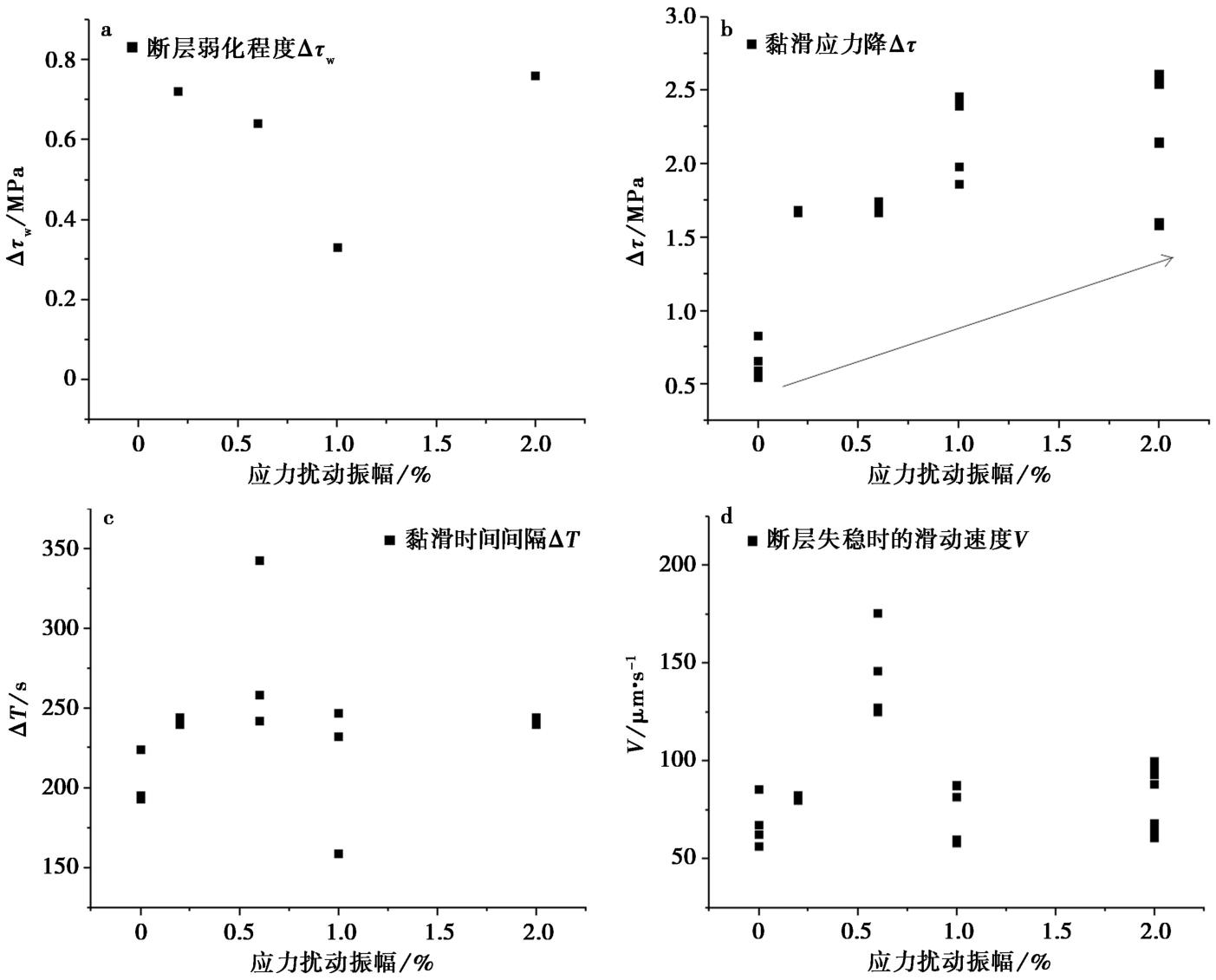
图5 正应力扰动振幅对盐岩断层泥黏滑行为的影响 a 断层弱化程度Δτw; b 黏滑应力降Δτ; c 黏滑时间间隔ΔT; d 黏滑失稳时断层的滑动速度V(由LVDT记录计算得到)
Fig. 5 Effects of normal stress oscillation amplitudes on the stick-slip behavior of the halite gouge.
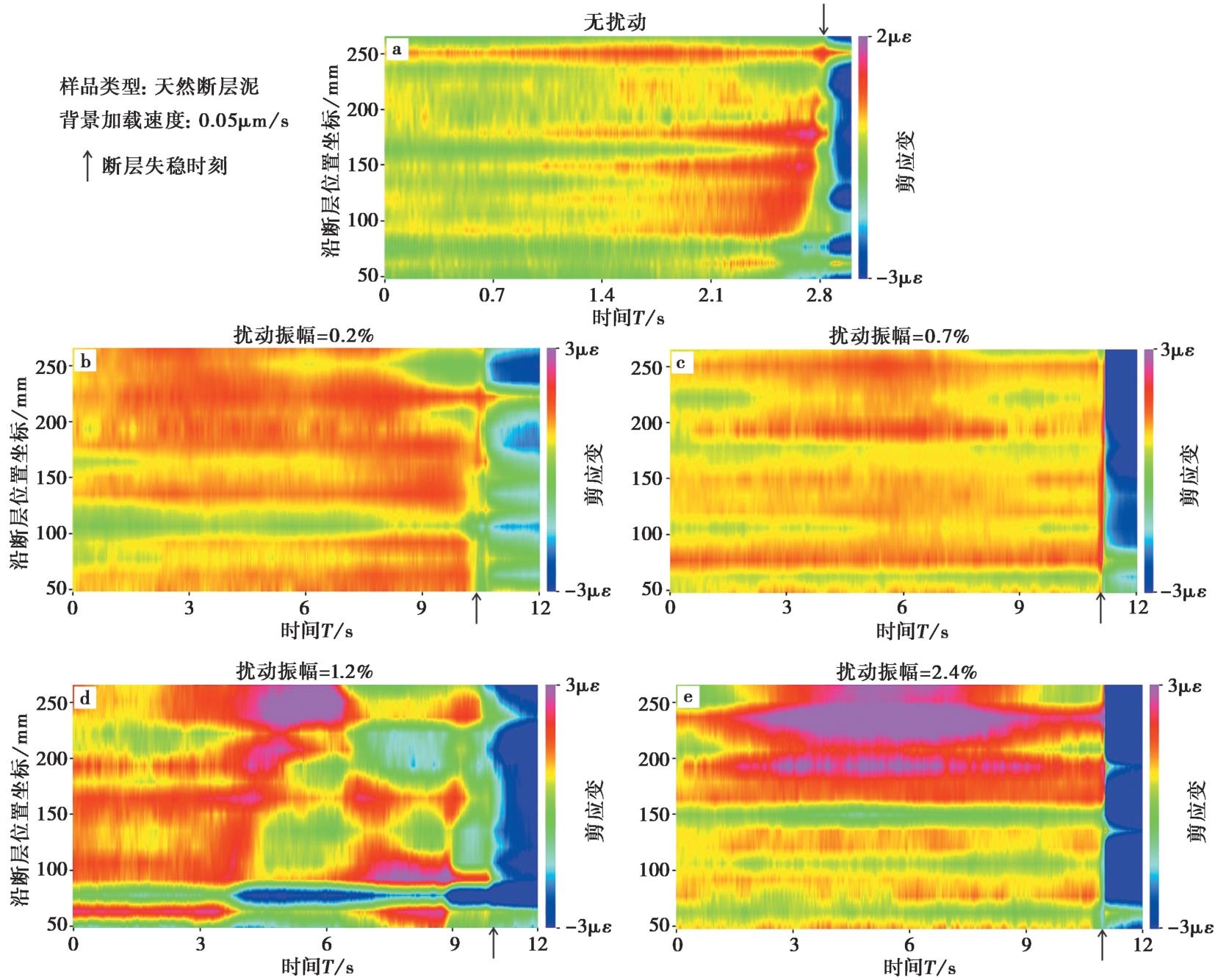
图6 断层失稳成核和破裂期间, 不同正应力扰动振幅下沿断层剪应变的时空演化 a 无正应力扰动; b—e 正应力扰动振幅从0.2%增至2.4%对应的实验结果。实验断层内部填充天然断层泥
Fig. 6 Spatial and temporal evolution of the fault shear strain at the instability nucleation and rupture stage.
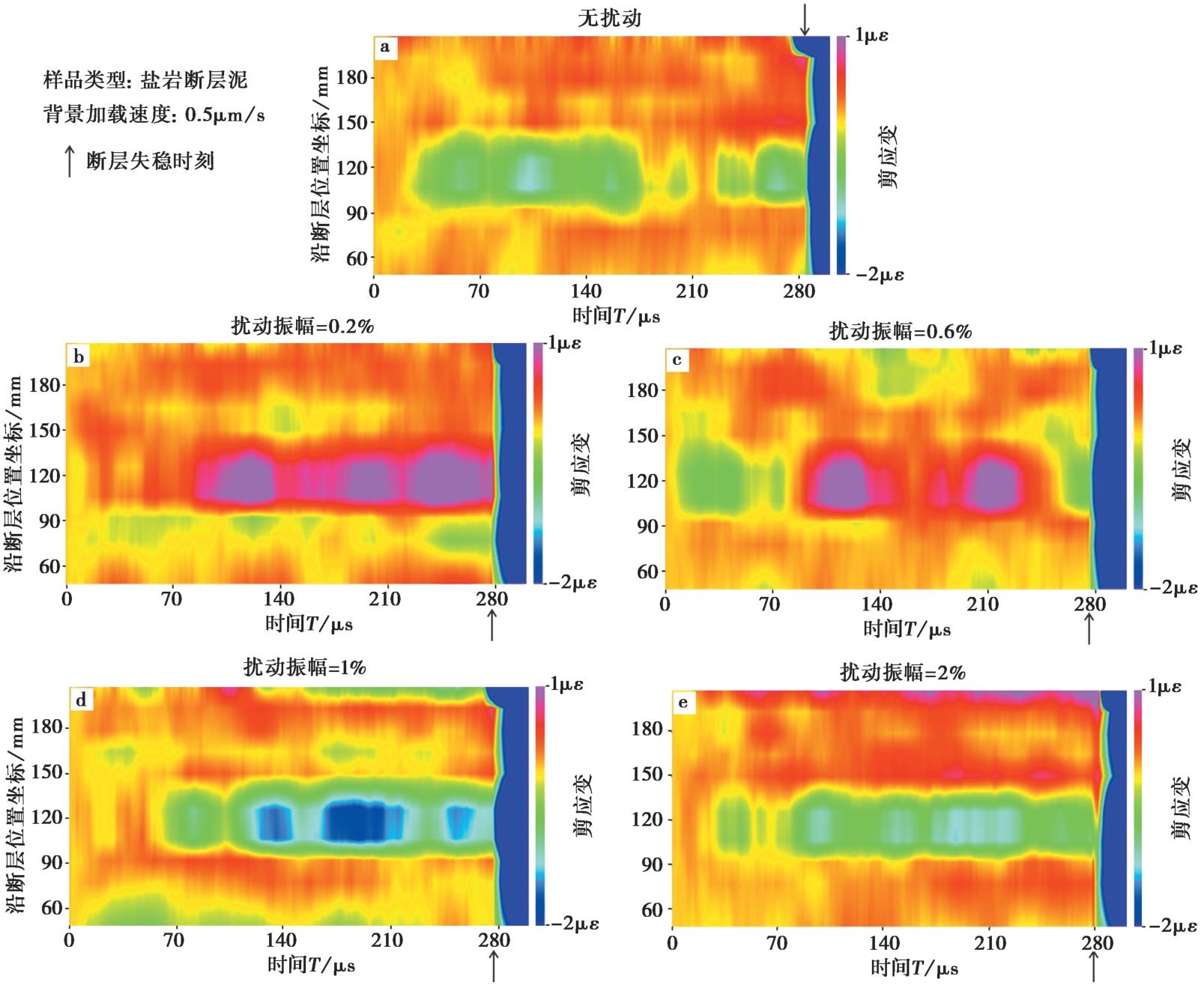
图7 断层失稳成核和破裂期间, 不同正应力扰动振幅下沿断层剪应变的时空分布情况 a 无正应力扰动; b—e正应力扰动振幅从0.2%增至2%对应的实验结果。实验断层内部填充盐岩断层泥
Fig. 7 Spatial and temporal distribution of the fault shear strain at the instability nucleation and rupture stage.

图8 一个黏滑周期内应力扰动振幅对含天然断层泥的实验断层沿走向方向正应变分布的影响
Fig. 8 Effects of normal stress oscillation amplitudes on the along-strike normal strain distribution for the experimental fault that was filled with the natural fault gouge.
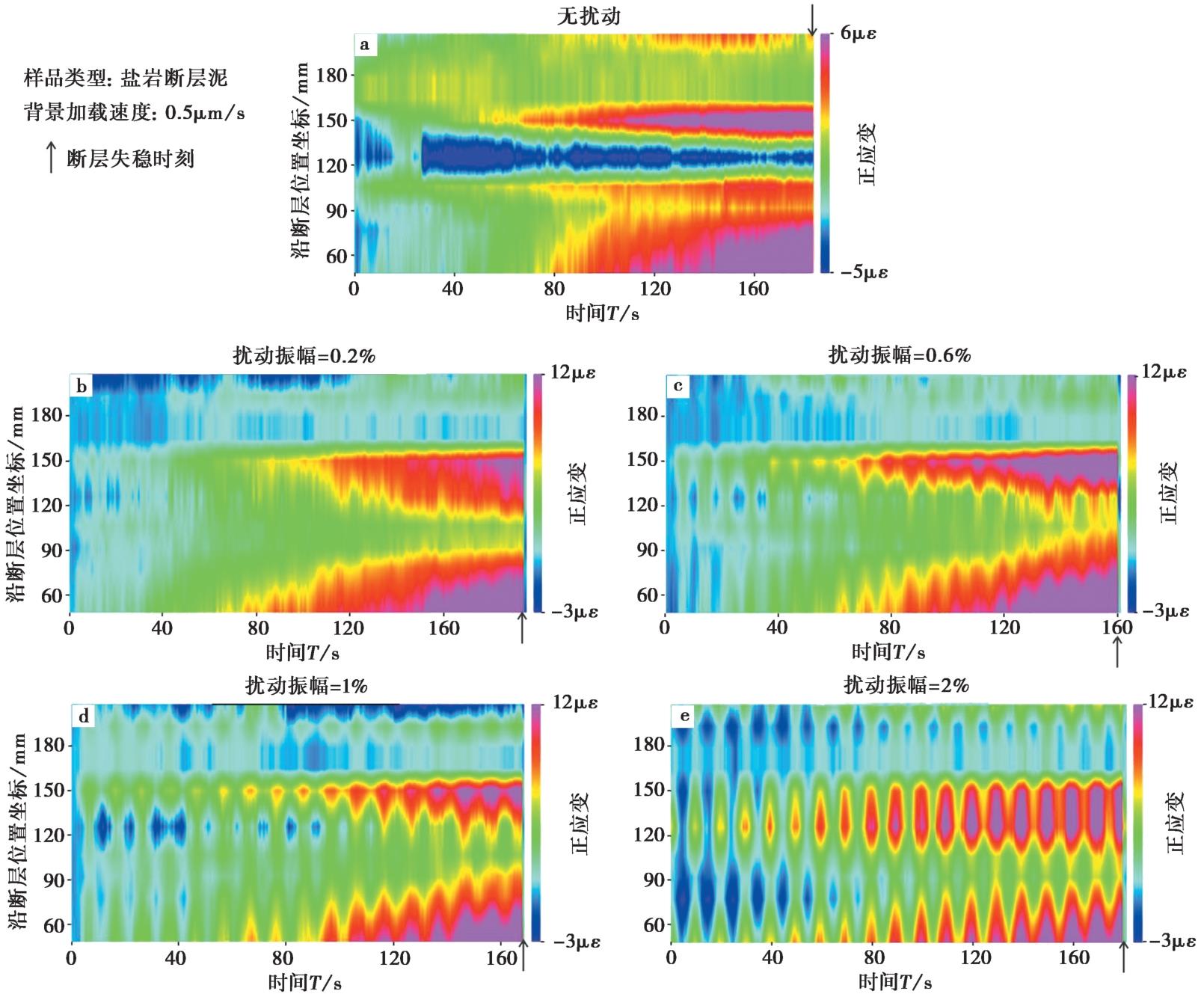
图9 一个黏滑周期内应力扰动振幅对含盐岩断层泥的实验断层沿走向方向正应变分布的影响
Fig. 9 Effects of normal stress oscillation amplitudes on the along-strike normal strain distribution for the experimental fault that was filled with the halite gouge.
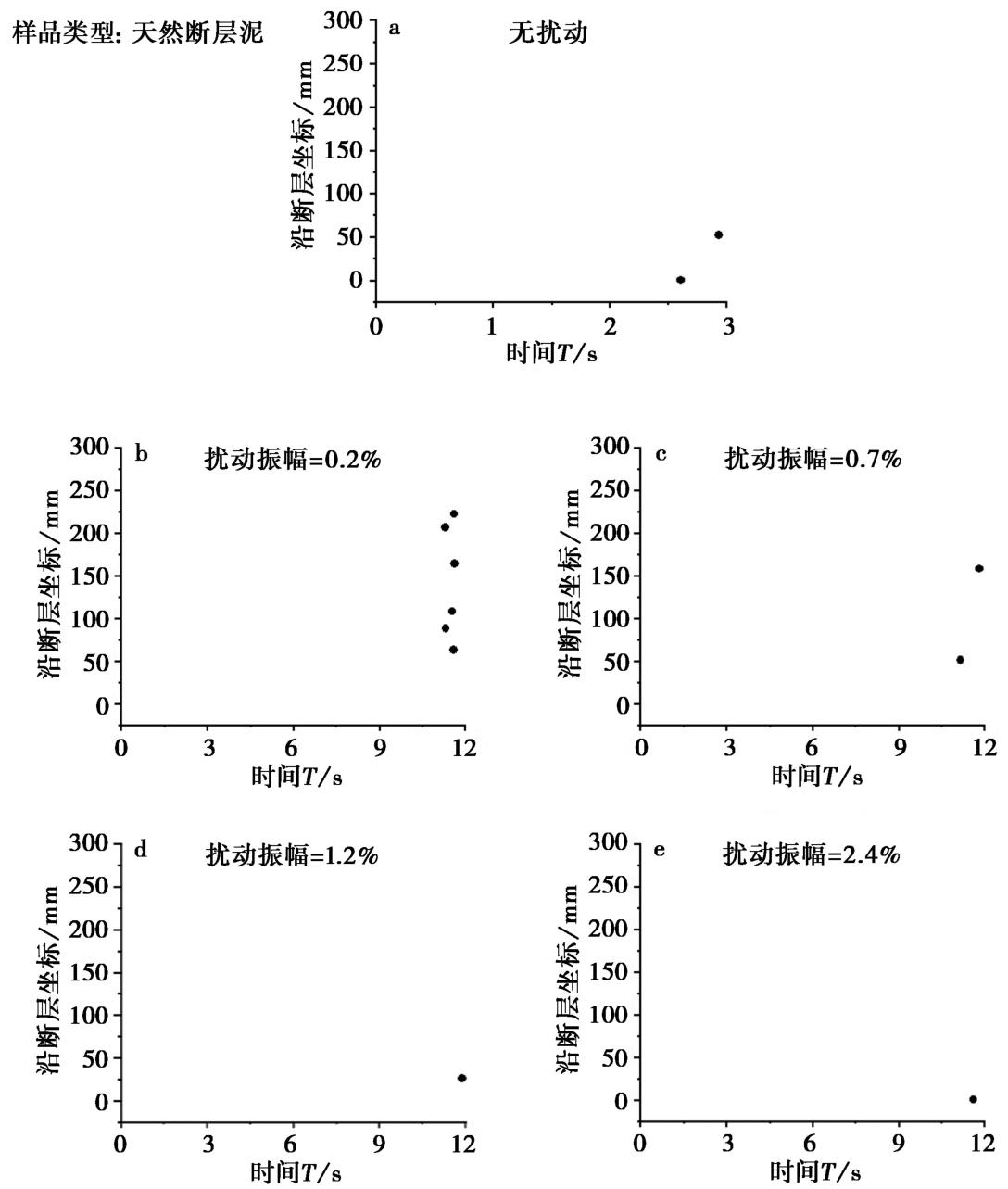
图10 应力扰动振幅对天然断层泥一次黏滑发生前一段时间内声发射事件时空演化规律的影响 x轴末端代表黏滑发生时刻。破裂前无数据点代表无声发射事件发生
Fig. 10 Effects of normal stress oscillation amplitudes on the spatio-temporal evolution of the AE events for the natural fault gouge.
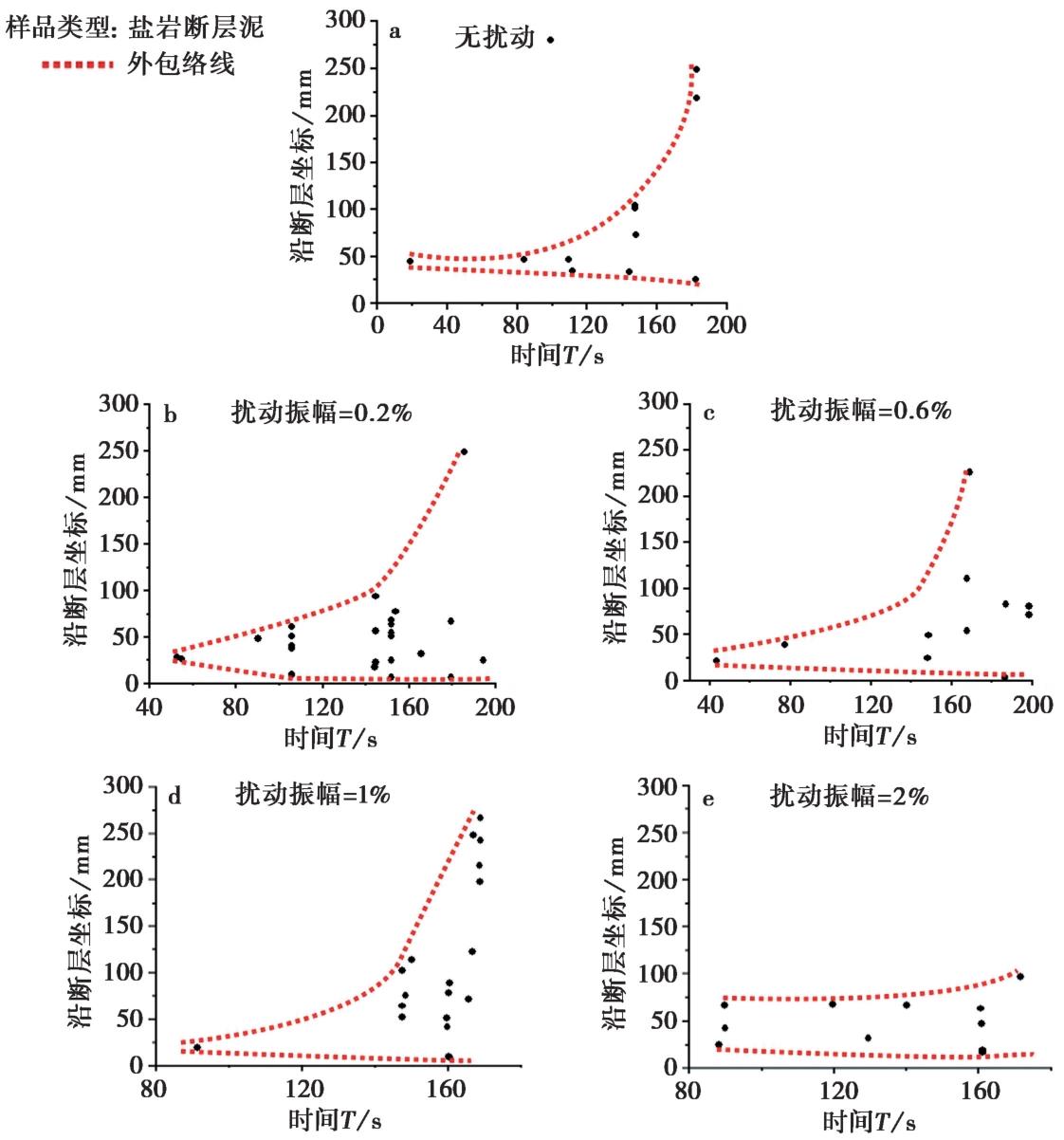
图11 应力扰动振幅对盐岩断层泥一次黏滑发生前一段时间内声发射事件时空演化规律的影响 x轴末端代表黏滑发生时刻
Fig. 11 Effects of normal stress oscillation amplitudes on the spatio-temporal evolution of the AE events for the halite gouge.
| [1] |
崔永权, 马胜利, 刘力强. 2005. 侧向应力扰动对断层摩擦影响的实验研究[J]. 地震地质, 27(4): 645—652.
|
|
|
|
| [2] |
黄元敏, 马胜利, 缪阿丽, 等. 2009. 剪切载荷扰动对断层摩擦影响的实验研究[J]. 地震地质, 31(2): 276—286.
|
|
|
|
| [3] |
黄元敏, 马胜利, 缪阿丽, 等. 2016. 正应力扰动对断层滑动失稳影响的实验研究[J]. 地球物理学报, 59(3): 931—940.
|
|
|
|
| [4] |
刘培洵, 刘力强, 陈顺云, 等. 2007. 实验室声发射三维定位软件[J]. 地震地质, 29(3): 674—679.
|
|
|
|
| [5] |
马胜利, 缪阿丽, 黄元敏. 2011. 应力扰动对断层摩擦声发射活动影响的实验研究[J]. 西北地震学报, 33(1): 1—8, 19.
|
|
|
|
| [6] |
缪阿丽, 马胜利, 侯林锋, 等. 2012. 岩盐断层带摩擦滑动的速度依赖性转换及其地震学意义[J]. 地球物理学报, 55(10): 3307—3317.
|
|
|
|
| [7] |
张卓然, 魏斌, 申宗航, et al. 2020. 2016年度呼图壁地下天然储气库对周缘微地震活动性的影响[J]. 地球物理学报, 63(9): 3387—3397.
|
|
|
|
| [8] |
|
| [9] |
|
| [10] |
|
| [11] |
|
| [12] |
|
| [13] |
|
| [14] |
|
| [15] |
|
| [16] |
|
| [17] |
|
| [18] |
|
| [19] |
|
| [20] |
|
| [21] |
|
| [22] |
|
| [23] |
|
| [24] |
|
| [25] |
|
| [26] |
|
| [27] |
|
| [28] |
|
| [29] |
|
| [30] |
|
| [31] |
|
| [32] |
|
| [33] |
|
| [34] |
|
| [35] |
|
| [36] |
|
| [1] | 邵康, 刘金锋, 谢彬, 朱民杰. 正应力和含水率对花岗岩断层泥摩擦特性和声发射特征的影响[J]. 地震地质, 2024, 46(6): 1332-1356. |
| [2] | 赵乾百, 赵永, 杨天鸿, 滕龙, 王述红, 刘一龙. 不同微观裂隙密度下断层黏滑失稳规律离散元模拟[J]. 地震地质, 2024, 46(6): 1357-1373. |
| [3] | 杨海明, 陈顺云, 刘培洵, 郭彦双, 卓燕群, 齐文博. 岩石加载变形过程中超声尾波与声发射变化的实验[J]. 地震地质, 2020, 42(3): 715-731. |
| [4] | 李世念, 齐文博, 刘力强. 超动态变形场长时间观测系统[J]. 地震地质, 2019, 41(6): 1529-1538. |
| [5] | 韩竹军, 张秉良, 曾新福, 卢福水, 郭鹏. 江西中北部基岩区断层泥显微构造特征及意义[J]. 地震地质, 2018, 40(4): 903-919. |
| [6] | 刘洋, 何昌荣. 龙门山断层带浅钻花岗岩中断层泥的摩擦本构参数[J]. 地震地质, 2017, 39(5): 917-933. |
| [7] | 赵扬锋, 刘力强, 潘一山. 单轴压缩下含断层带花岗岩声发射、微震和电荷感应实验[J]. 地震地质, 2017, 39(5): 964-980. |
| [8] | 雷兴林, 李霞颖, 李琦, 马胜利, 付碧宏, 崔银祥. 沉积岩储藏系统小断层在油气田注水诱发地震中的作用——以四川盆地为例[J]. 地震地质, 2014, 36(3): 625-643. |
| [9] | 马胜利, 姚路, 嶋本利彦, 東郷徹宏, 侯林锋, 王羽. 岩石高速摩擦实验的进展[J]. 地震地质, 2014, 36(3): 814-824. |
| [10] | 张雷, 何昌荣. 龙门山映秀-北川断裂平溪黑色断层泥中有机质成分分析及对断层摩擦滑动性质的影响[J]. 地震地质, 2014, 36(3): 896-906. |
| [11] | 郭玲莉, 刘力强, 刘培洵. 多通道动态应变观测系统在地震模拟实验中的应用[J]. 地震地质, 2014, 36(3): 929-938. |
| [12] | 袁仁茂, 张秉良, 徐锡伟, 林传勇. 汶川地震北川-映秀断裂北段断层泥显微构造和黏土矿物特征及其意义[J]. 地震地质, 2013, 35(4): 685-700. |
| [13] | 曹凤娟, 王亮, 焦明若, 翟丽娜, 王岩. 2012年2月2日盖州ML4.7震群序列特征及发震构造探讨[J]. 地震地质, 2013, 35(4): 842-852. |
| [14] | 李普春, 刘力强, 郭玲莉, 刘培洵. 粘滑过程中的多点错动[J]. 地震地质, 2013, 35(1): 125-137. |
| [15] | 党嘉祥, 周永胜, 韩亮, 何昌荣, 陈建业, 党新增, 杨晓松. 虹口八角庙-深溪沟炭质泥岩同震断层泥的X射线衍射分析结果[J]. 地震地质, 2012, 34(1): 17-27. |
| 阅读次数 | ||||||
|
全文 |
|
|||||
|
摘要 |
|
|||||